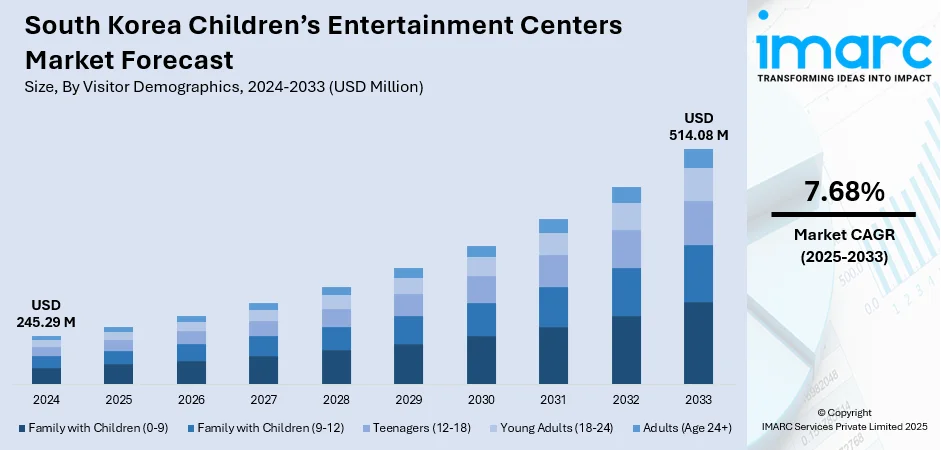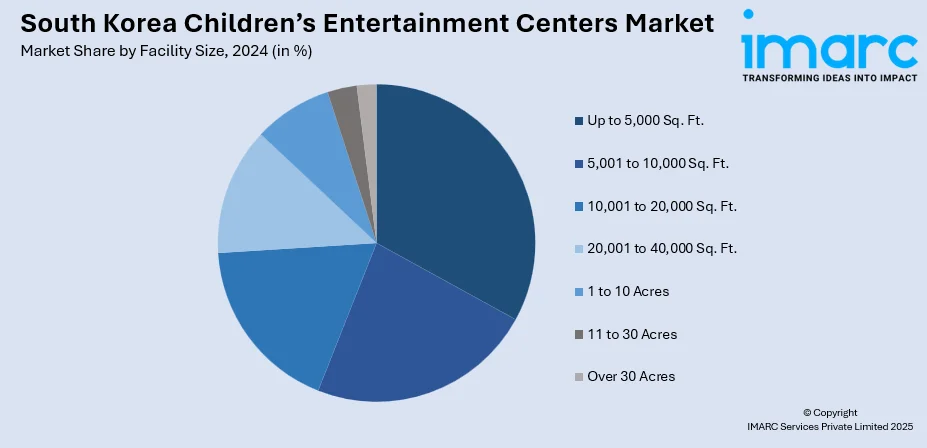
South Korea Children’s Entertainment Centers Market Size, Share, Trends and Forecast by Visitor Demographics, Facility Size, Revenue Source, Activity Area, and Region, 2025-2033
South Korea Children’s Entertainment Centers Market Overview:
The South Korea children’s entertainment centers market size reached USD 245.29 Million in 2024. Looking forward, IMARC Group expects the market to reach USD 514.08 Million by 2033, exhibiting a growth rate (CAGR) of 7.68% during 2025-2033. Rising disposable incomes, urbanization, and a growing middle class are some of the factors contributing to the South Korea children’s entertainment centers market share. Increased demand for experiential family activities, integration of digital technologies, and themed play zones further boost growth. Government support for family-oriented leisure infrastructure strengthens market expansion.
|
Report Attribute
|
Key Statistics
|
|---|---|
|
Base Year
|
2024
|
|
Forecast Years
|
2025-2033
|
|
Historical Years
|
2019-2024
|
| Market Size in 2024 | USD 245.29 Million |
| Market Forecast in 2033 | USD 514.08 Million |
| Market Growth Rate 2025-2033 | 7.68% |
South Korea Children’s Entertainment Centers Market Trends:
Immersive Digital Playgrounds and AR Integration
Children’s entertainment centers in South Korea are rapidly adopting interactive digital technologies to create immersive experiences. AR-based playgrounds and projection mapping systems are now standard attractions, allowing children to interact with animated environments that respond to their movements. Digital ball pits, sensor-based climbing walls, and VR game zones are replacing traditional static play structures. Parents are drawn to these tech-enhanced setups due to their ability to combine entertainment with cognitive and motor skill development. Operators are also collaborating with Korean animation studios to incorporate popular characters into digital story-based play areas, making the experience highly engaging. The rise of “smart play zones” equipped with AI-driven activity tracking is another key factor. These systems give parents insights into their child’s physical activity levels and learning progress while playing. With South Korea’s advanced tech infrastructure and strong consumer preference for cutting-edge experiences, this trend continues to grow, blending entertainment with education in a way that resonates with modern families.

To get more information on this market, Request Sample
Eco-Friendly and Sensory-Focused Play Spaces
A contrasting trend in South Korea’s children’s entertainment centers revolves around eco-conscious and nature-themed experiences. Parents are increasingly valuing sustainability and natural play, leading to a demand for centers designed with recycled materials, wooden structures, and soft, toxin-free flooring. Indoor spaces are incorporating greenery, natural light, and water features to create calming environments that mimic outdoor play. Sensory-based zones with tactile walls, soundscapes, and organic textures are gaining popularity among parents of younger children and those seeking alternatives to screen-heavy environments. The focus is on open-ended play that encourages creativity, free exploration, and emotional well-being rather than digital interaction. Some centers even integrate miniature indoor gardens or small animal interaction areas, reinforcing a connection with nature. These concepts appeal strongly to health-conscious parents who want their children to experience a slower, more mindful form of entertainment. This shift suggests a market segment diverging from high-tech entertainment to offer a “green” and wholesome play experience.
South Korea Children’s Entertainment Centers Market Segmentation:
IMARC Group provides an analysis of the key trends in each segment of the market, along with forecasts at the country and regional levels for 2025-2033. Our report has categorized the market based on visitor demographics, facility size, revenue source, and activity area.
Visitor Demographics Insights:
- Family with Children (0-9)
- Family with Children (9-12)
- Teenagers (12-18)
- Young Adults (18-24)
- Adults (Age 24+)
The report has provided a detailed breakup and analysis of the market based on the visitor demographics. This includes family with children (0-9), family with children (9-12), teenagers (12-18), young adults (18-24), and adults (age 24+).
Facility Size Insights:

- Up to 5,000 Sq. Ft.
- 5,001 to 10,000 Sq. Ft.
- 10,001 to 20,000 Sq. Ft.
- 20,001 to 40,000 Sq. Ft.
- 1 to 10 Acres
- 11 to 30 Acres
- Over 30 Acres
The report has provided a detailed breakup and analysis of the market based on the facility size. This includes up to 5,000 sq. ft., 5,001 to 10,000 sq. ft., 10,001 to 20,000 sq. ft., 20,001 to 40,000 sq. ft., 1 to 10 acres, 11 to 30 acres, and over 30 acres.
Revenue Source Insights:
- Entry Fees and Ticket Sales
- Food and Beverages
- Merchandising
- Advertising
- Others
The report has provided a detailed breakup and analysis of the market based on the revenue source. This includes entry fees and ticket sales, food and beverages, merchandising, advertising, and others.
Activity Area Insights:
- Arcade Studios
- AR and VR Gaming Zone
- Physical Play Activities
- Skill/Competition Games
- Others
A detailed breakup and analysis of the market based on the activity area have also been provided in the report. This includes arcade studios, AR and VR gaming zone, physical play activities, skill/competition games, and others.
Regional Insights:
- Seoul Capital Area
- Yeongnam (Southeastern Region)
- Honam (Southwestern Region)
- Hoseo (Central Region)
- Others
The report has also provided a comprehensive analysis of all the major regional markets, which include Seoul Capital Area, Yeongnam (Southeastern Region), Honam (Southwestern Region), Hoseo (Central Region), and others.
Competitive Landscape:
The market research report has also provided a comprehensive analysis of the competitive landscape. Competitive analysis such as market structure, key player positioning, top winning strategies, competitive dashboard, and company evaluation quadrant has been covered in the report. Also, detailed profiles of all major companies have been provided.
South Korea Children’s Entertainment Centers Market Report Coverage:
| Report Features | Details |
|---|---|
| Base Year of the Analysis | 2024 |
| Historical Period | 2019-2024 |
| Forecast Period | 2025-2033 |
| Units | Million USD |
| Scope of the Report |
Exploration of Historical Trends and Market Outlook, Industry Catalysts and Challenges, Segment-Wise Historical and Future Market Assessment:
|
| Visitor Demographics Covered | Family With Children (0-9), Family With Children (9-12), Teenagers (12-18), Young Adults (18-24), Adults (Age 24+) |
| Facility Sizes Covered | Up to 5,000 Sq. Ft., 5,001 to 10,000 Sq. Ft., 10,001 to 20,000 Sq. Ft., 20,001 to 40,000 Sq. Ft., 1 to 10 Acres, 11 to 30 Acres, Over 30 Acres |
| Revenue Sources Covered | Entry Fees and Ticket Sales, Food and Beverages, Merchandising, Advertising, Others |
| Activity Areas Covered | Arcade Studios, AR and VR Gaming Zone, Physical Play Activities, Skill/Competition Games, Others |
| Regions Covered | Seoul Capital Area, Yeongnam (Southeastern Region), Honam (Southwestern Region), Hoseo (Central Region), Others |
| Customization Scope | 10% Free Customization |
| Post-Sale Analyst Support | 10-12 Weeks |
| Delivery Format | PDF and Excel through Email (We can also provide the editable version of the report in PPT/Word format on special request) |
Key Questions Answered in This Report:
- How has the South Korea children’s entertainment centers market performed so far and how will it perform in the coming years?
- What is the breakup of the South Korea children’s entertainment centers market on the basis of visitor demographics?
- What is the breakup of the South Korea children’s entertainment centers market on the basis of facility size?
- What is the breakup of the South Korea children’s entertainment centers market on the basis of revenue source?
- What is the breakup of the South Korea children’s entertainment centers market on the basis of activity area?
- What is the breakup of the South Korea children’s entertainment centers market on the basis of region?
- What are the various stages in the value chain of the South Korea children’s entertainment centers market?
- What are the key driving factors and challenges in the South Korea children’s entertainment centers market?
- What is the structure of the South Korea children’s entertainment centers market and who are the key players?
- What is the degree of competition in the South Korea children’s entertainment centers market?
Key Benefits for Stakeholders:
- IMARC’s industry report offers a comprehensive quantitative analysis of various market segments, historical and current market trends, market forecasts, and dynamics of the South Korea children’s entertainment centers market from 2019-2033.
- The research report provides the latest information on the market drivers, challenges, and opportunities in the South Korea children’s entertainment centers market.
- Porter's five forces analysis assist stakeholders in assessing the impact of new entrants, competitive rivalry, supplier power, buyer power, and the threat of substitution. It helps stakeholders to analyze the level of competition within the South Korea children’s entertainment centers industry and its attractiveness.
- Competitive landscape allows stakeholders to understand their competitive environment and provides an insight into the current positions of key players in the market.
Need more help?
- Speak to our experienced analysts for insights on the current market scenarios.
- Include additional segments and countries to customize the report as per your requirement.
- Gain an unparalleled competitive advantage in your domain by understanding how to utilize the report and positively impacting your operations and revenue.
- For further assistance, please connect with our analysts.
 Request Customization
Request Customization
 Speak to an Analyst
Speak to an Analyst
 Request Brochure
Request Brochure
 Inquire Before Buying
Inquire Before Buying




.webp)




.webp)












